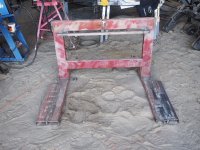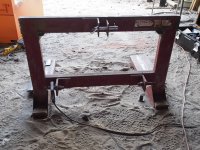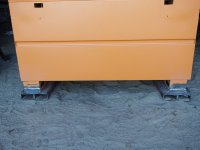Luke'sScreenName
Elite Member
- Joined
- Mar 1, 2015
- Messages
- 3,710
- Location
- Lakes Region, NH
- Tractor
- Kubota MX4800 with BH-90X hoe; Hustler FastTrack 48; B3300SU (sold); 1969 Case 680B CK (sold)
Also, tangentially, if max capacity is important to



Wow, great job on the box, aarolar. Obviously, you can weld and work with sheet metal. I have never welded a single thing but I am thinking of buying a beginner's welder and learning how. I had a dedicated 220v outlet installed in our shed just for that purpose. If you have time and are willing, send me a PM and give me some suggestions for a starter welder. Thanks much.
How much difference would your bush hog make to the load on the front axel? The bush hog might allow for heavier loading of the front axel because the hydraulics weren't maxed out before. Even if you were lifting the exact same load on the FEL you haven't changed the front axel weight by more than a few hundred pounds. Proportionality that's pretty minor. The absolute best thing you could do for you front axel would be taking it out of 4wd. It's possible to load the front axel far heavier ( assuming there's adequate ballast in place ) by backing up while the loader is unmovable. Not to mention all of the binding that occurs.With my 700# 7' rear blade and loaded R1 tires with WW fluid, I can lift the back tires if I am picking something that is too heavy....or trying to pry out a log/root/stump or other immovable object. That means I am getting the full force of whatever force the loader can exert before the back tires come up + the full weight of the tractor + the full weight of the ballast in the tires + the 700# blade on the back......ALL on the front axle. While Not having any weight box on the back actually loads the front axle LESS than having weight back there, but not having enough of it. R1 vs R4 as well as liquid of choice make a different in weights. R4's hold more, Beet juice is heavier than WW fluid. I think I got something like 48 gallons of WW fluid in my R1's. So I've only got ~750-800# in the tires. But thats for traction when plowing, and stability. SHOULDNT be relied on for countering the front loader. Again, I am talking about doing heavy work though. Hard digging, logging, prying on stumps, etc. If you are just moving loose dirt, a bucket load of that is ~50% of what the loader can actually lift. Or if you are lifting ~800# implements off a trailer, moving around a bucket load of firewood, pushing brush piles, etc......all I would consider lighter work that dont involve lifting near max capacity. In which case, 750# should be fine.